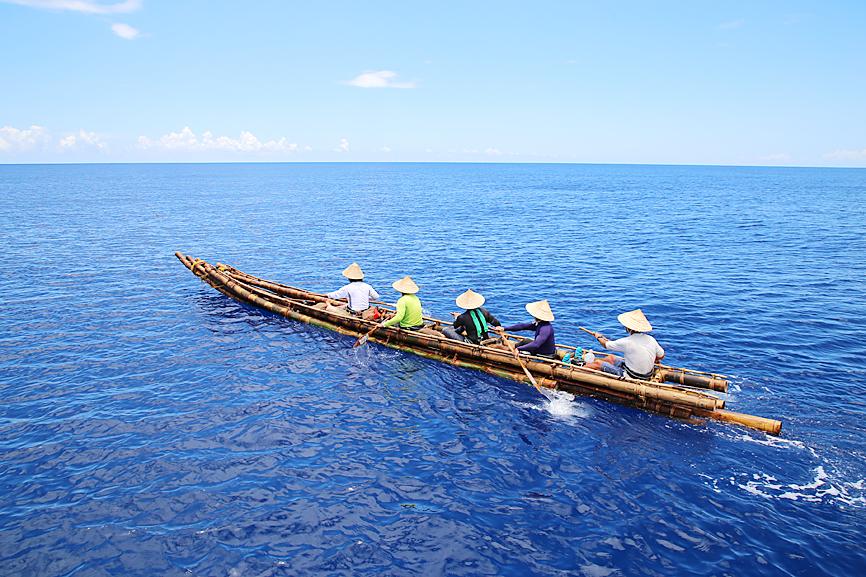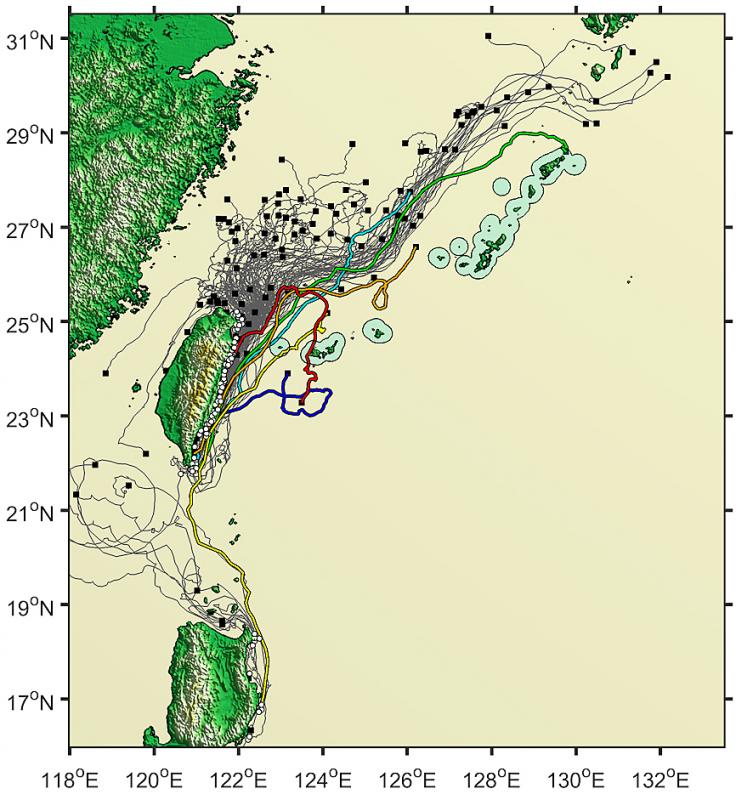About 30,000 years ago, ancient inhabitants of Taiwan might have intentionally crossed the Kuroshio, one of the world’s strongest currents, researchers found.
They might have searched for a new habitat and reached the Ryukyu Islands in Japan, said a study, titled “Palaeolithic voyage for invisible islands beyond the horizon,” which was published in the journal Scientific Reports on Thursday.
The study, led by anthropologist Yousuke Kaifu, a ancient history researcher at the University of Tokyo, is part of a project on maritime migration of Paleolithic people 35,000 to 30,000 years ago.

Photo courtesy of University of Tokyo professor Yousuke Kaifu
While some of them are believed to have migrated from Taiwan to the Ryukyu Islands, it has been unclear whether their voyages were made by chance or choice.
“I had been seeking a good way to demonstrate the intentionality of the sea crossings, but had no idea what to do. Then, I ... came across the idea of using the tracking buoys,” Kaifu wrote in an e-mail to the Taipei Times.
Kaifu, with the help of Jan Sen (詹森), a professor at National Taiwan University’s Institute of Oceanography, and former technician Kuo Tien-hsia (郭天俠), analyzed data of the movements of 138 satellite-tracked buoys that drifted past the Philippines, Taiwan and Japan from 1989 to 2017.

Photo courtesy of former National Taiwan University technician Kuo Tien-hsia
The methodology was predicated on some evidence showing that the Kuroshio’s flow remained unchanged over the past 100,000 years, the team said.
Of the 122 buoys that drifted past Taiwan, 114 were carried northward by the Kuroshio, and of these, only three came within 20km of the central and southern Ryukyu Islands, the researchers found.
This usually happened under severe weather conditions, such as typhoons and northeasterly monsoons, they found.
Of the 16 buoys that drifted past the Philippine main island of Luzon, only one drifted toward the Ryukyu Islands, they found.
The ancient sailors could not have reached the Ryukyu Islands through random drifting, whereas bad weather conditions, although occasionally bringing some buoys closer to the islands, are unlikely to have been used by the ancient seafarers, Jan said.
Yonaguni Island, the westernmost of the Ryukyu Islands, is in good weather conditions visible from some mountains in eastern Taiwan, he added.
The movements of the buoys, originally deployed by the US-led Surface Velocity Program, show the possible routes of ancient voyages, Jan said, adding that their method can be described as “mining old data for a new application.”
Asked if there were conditions unfavorable for survival in Taiwan that prompted the Paleolithic people to move, Kaifu said that if there were such conditions, people might have sought to relocate within Taiwan.
“You really do not have to go to that remote island, but they did,” Kaifu said. “I think that is human nature.”
“It must be a one-way trip. The Kuroshio current is too strong to come back, even if they plan a round trip,” he added.
In July last year, a team of five paddled from Taitung to Yonaguni Island in a logboat, covering the 225km in 45 hours.
Kaifu said he seeks to document the research in further academic papers, books and films, including a short film that would be screened in Tokyo this month.
Asked if the migration from Taiwan was the first known sea crossing to Japan, Kaifu said that ancient populations also crossed the sea from the Korean Peninsula, adding that the first residents of the Ryukyu Islands were not necessarily the ancestors of modern Japanese.
“This project is to highlight a part of interesting human histories, not to applaud someone. I do not want to be nationalistic in my anthropological studies,” he said.

SHIPS, TRAINS AND AUTOMOBILES: The ministry has announced changes to varied transportation industries taking effect soon, with a number of effects for passengers Beginning next month, the post office is canceling signature upon delivery and written inquiry services for international registered small packets in accordance with the new policy of the Universal Postal Union, the Ministry of Transportation and Communications said yesterday. The new policy does not apply to packets that are to be delivered to China, the ministry said. Senders of international registered small packets would receive a NT$10 rebate on postage if the packets are sent from Jan. 1 to March 31, it added. The ministry said that three other policies are also scheduled to take effect next month. International cruise ship operators

HORROR STORIES: One victim recounted not realizing they had been stabbed and seeing people bleeding, while another recalled breaking down in tears after fleeing A man on Friday died after he tried to fight the knife-wielding suspect who went on a stabbing spree near two of Taipei’s busiest metro stations, Taipei Mayor Chiang Wan-an (蔣萬安) said. The 57-year-old man, identified by his family name, Yu (余), encountered the suspect at Exit M7 of Taipei Main Station and immediately tried to stop him, but was fatally wounded and later died, Chiang said, calling the incident “heartbreaking.” Yu’s family would receive at least NT$5 million (US$158,584) in compensation through the Taipei Rapid Transit Corp’s (TRTC) insurance coverage, he said after convening an emergency security response meeting yesterday morning. National

The Forestry and Nature Conservation Agency yesterday launched a gift box to market honey “certified by a Formosan black bear” in appreciation of a beekeeper’s amicable interaction with a honey-thieving bear. Beekeeper Chih Ming-chen (池明鎮) in January inspected his bee farm in Hualien County’s Jhuosi Township (卓溪) and found that more than 20 beehives had been destroyed and many hives were eaten, with bear droppings and paw prints near the destroyed hives, the agency said. Chih returned to the farm to move the remaining beehives away that evening when he encountered a Formosan black bear only 20m away, the agency said. The bear

PLANNED: The suspect visited the crime scene before the killings, seeking information on how to access the roof, and had extensively researched a 2014 stabbing incident The suspect in a stabbing attack that killed three people and injured 11 in Taipei on Friday had planned the assault and set fires at other locations earlier in the day, law enforcement officials said yesterday. National Police Agency (NPA) Director-General Chang Jung-hsin (張榮興) said the suspect, a 27-year-old man named Chang Wen (張文), began the attacks at 3:40pm, first setting off smoke bombs on a road, damaging cars and motorbikes. Earlier, Chang Wen set fire to a rental room where he was staying on Gongyuan Road in Zhongzheng District (中正), Chang Jung-hsin said. The suspect later threw smoke grenades near two exits